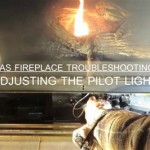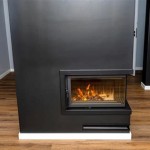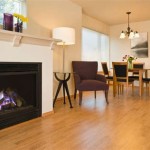Portable Indoor Outdoor Fireplaces: Bringing Ambiance and Warmth Anywhere
The concept of a fireplace traditionally evokes images of a fixed, often masonry-built structure, deeply integrated into the architectural design of a building. However, advancements in technology and design have led to the development of portable indoor outdoor fireplaces, devices that offer the ambiance and warmth of a traditional fireplace with the added benefit of mobility and versatility. These fireplaces are not intended to fully replace central heating systems but are designed to provide supplemental warmth and a visual focal point in a variety of settings.
Portability is perhaps the defining characteristic of these fireplaces. Unlike their traditional counterparts, portable models can be moved from room to room or even taken outdoors, allowing users to enjoy the comforting presence of a fire in different locations. This adaptability makes them suitable for apartments, condos, or homes where installing a permanent fireplace is not feasible or desired. They also cater to outdoor enthusiasts who wish to bring a touch of luxury and warmth to their patios, decks, or camping trips.
The types of portable indoor outdoor fireplaces vary significantly, each with its own set of advantages and disadvantages. These include gel fuel fireplaces, ethanol fireplaces, electric fireplaces, and propane or gas-powered fireplaces. Each type utilizes a different fuel source and offers varying levels of heat output, aesthetics, and safety considerations. Understanding the nuances of each type is crucial for making an informed purchasing decision.
Gel Fuel Fireplaces: Emitting a Clean, Realistic Flame
Gel fuel fireplaces utilize canisters of gelled alcohol-based fuel to produce a flame. These canisters are typically placed within a decorative housing, such as a metal or stone surround, and lit with a match or lighter. The gel fuel burns cleanly, producing minimal smoke, soot, or ash. This makes them suitable for indoor use without requiring a chimney or venting system. The flame produced by gel fuel is often very realistic, mimicking the look of a wood-burning fire.
The primary advantage of gel fuel fireplaces is their ease of use and portability. The canisters are readily available at many retailers, and they are easy to ignite and extinguish. They also offer a relatively low heat output, making them ideal for creating ambiance without overheating a room. However, the cost of gel fuel can be a significant ongoing expense, as each canister typically burns for only a few hours. Furthermore, gel fuel fireplaces are not considered a primary source of heat and are more for aesthetic purposes.
Safety considerations are paramount when using gel fuel fireplaces. It is crucial to follow all manufacturer instructions regarding fuel canister placement, refueling procedures, and ventilation. Refueling should only be done when the flame is completely extinguished and the canister is cool to the touch. While gel fuel burns cleanly, it still consumes oxygen, so it's important to ensure adequate ventilation in the room. Also, never leave a burning gel fuel fireplace unattended, especially around children or pets.
Ethanol Fireplaces: A Modern and Sustainable Option
Ethanol fireplaces, also known as bioethanol fireplaces, use liquid ethanol fuel derived from renewable sources such as corn or sugarcane. This fuel burns cleanly, producing only water vapor and carbon dioxide as byproducts. Similar to gel fuel fireplaces, ethanol fireplaces do not require a chimney or venting system, making them suitable for indoor use in a variety of spaces. They are often praised for their modern aesthetic, with sleek designs that complement contemporary decor.
A key benefit of ethanol fireplaces is their environmental friendliness. Ethanol is a renewable fuel source, and its combustion results in minimal environmental impact compared to fossil fuels. They also offer a decent heat output, capable of warming smaller rooms. The flame produced by ethanol is usually aesthetically pleasing, often creating a vertical column of fire.
The cost of ethanol fuel is a factor to consider. While it may be slightly more expensive than some other fuel options, the environmental benefits may outweigh the cost for some users. Refilling an ethanol fireplace requires careful handling of the liquid fuel. Spillage can be a fire hazard, so it’s important to use a funnel and avoid overfilling. As with gel fuel fireplaces, adequate ventilation is essential. Though the byproducts released are minimal, they still displace oxygen. Always refer to the manufacturer's instructions for safe operation and maintenance.
Electric Fireplaces: Convenience and Versatility
Electric fireplaces operate by using electricity to generate heat and simulate the appearance of flames. They typically consist of a heating element and a visual display, often utilizing LED lights and reflective surfaces to create a realistic flickering effect. Electric fireplaces come in a wide range of styles, from freestanding units to wall-mounted models, and even inserts that can be placed in existing fireplace openings. The portability of an electric fireplace is primarily dictated by its size and weight, but many models are designed to be easily moved.
One of the main advantages of electric fireplaces is their convenience. They require no fuel; simply plug them into a standard electrical outlet and turn them on. They also offer precise temperature control, allowing users to adjust the heat output to their desired level. The visual flame effect can be operated independently of the heating element, allowing users to enjoy the ambiance of a fire without adding heat to the room. This can be advantageous during warmer months.
Electric fireplaces are generally safe to use, as they do not produce an open flame or emit harmful byproducts. However, it's important to follow basic electrical safety precautions. Avoid overloading circuits, using extension cords inappropriately, and ensuring the unit is properly grounded. While the visual flame effect is appealing, it is important to note that it is a simulation and may not be as realistic as the flame produced by fuel-burning fireplaces. The reliance on electricity makes electric fireplaces dependent on a functioning power grid, which could be a limitation during power outages.
Propane and Gas-Powered Fireplaces: Higher Heat Output and Outdoor Durability
Propane and gas-powered portable fireplaces utilize propane or natural gas as their fuel source. These fireplaces typically feature a burner system that is connected to a propane tank or a natural gas line. They are often designed for outdoor use, offering a higher heat output than gel or ethanol fireplaces. Propane and gas fireplaces are commonly used on patios, decks, and in outdoor living spaces, providing warmth and ambiance for gatherings.
The primary benefit of propane and gas fireplaces is their ability to generate significant heat, making them suitable for colder outdoor temperatures. They also offer a continuous fuel supply, as long as the propane tank is full or the natural gas line is connected. Many models feature adjustable flame height controls, allowing users to customize the heat output and visual effect.
Safety considerations are crucial when using propane or gas-powered fireplaces. Proper ventilation is essential to prevent the buildup of carbon monoxide, a colorless and odorless gas that can be deadly. Never use a propane or gas fireplace indoors or in enclosed spaces. Inspect the connections regularly for leaks. Follow all manufacturer instructions for safe operation and maintenance, including proper tank storage and ignition procedures. While these fireplaces can be portable, they are significantly heavier and bulkier than gel or ethanol models due to the size of the propane tank or the need for a gas line connection.
The selection of a portable indoor outdoor fireplace depends heavily on individual needs and preferences. Factors to consider include the desired heat output, portability requirements, aesthetic preferences, fuel costs, and safety considerations. Each type of fireplace offers a unique set of advantages and disadvantages, and a careful evaluation of these factors is essential for making an informed decision. Before purchasing, reviewing product specifications, reading customer reviews, and understanding the manufacturer's safety guidelines are highly recommended.

Modern Mobile Fireplaces Portable Indoor Outdoor Fireplace

Sei Loft Portable Indoor Outdoor Fireplace Com

Pin On Fireplace

Tabletop Fire Pit Rectangular Indoor Or Outdoor Ventless Fireplace Clean Burning Portable Heat With 360 View By Northwest Black Target

Tabletop Fire S Portable Bio Fireplace Indoor Outdoor Mini Bowl Ca

Tripod Indoor Outdoor Portable Ethanol Fireplace Brookstone

Mini T Portable Indoor Outdoor Fire Pit Mad Ecosmart

Portable Indoor Outdoor Ethanol Fire Place Touch Of Modern

FlÎkr Fire Square Portable Indoor Outdoor Fireplace Bundle With Snuff Mellow Monkey

Tabletop Fire Pit Indoor Or Outdoor Smokeless Portable Fireplace Clean Burning Ventless Cylinder With Real Flame By Northwest Silver Target
Related Posts








